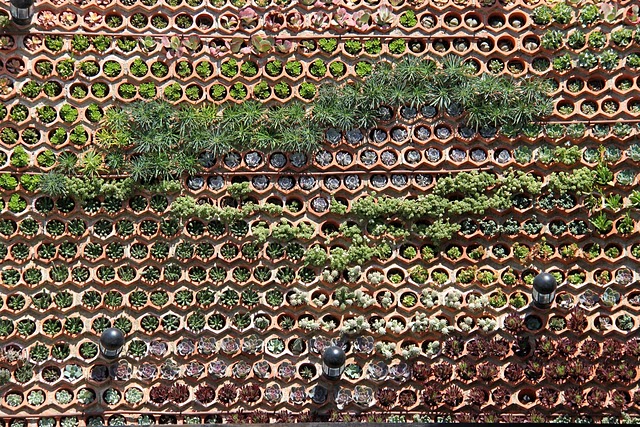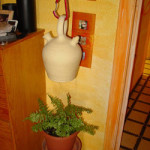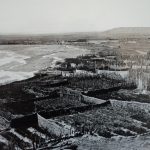“Jardín vertical low-tech en Ibiza” by Spanish architects Urbanarbolismo. The garden acts as a sound barrier between a club’s outdoor central courtyard and nearby appartments. The ceramic elements – used as a planting medium – are placed so that irrigation water can easily enter from above. No automated irrigation systems are required. Urbanarbolismo makes use of local plant varieties.
Low-tech Vertical Garden in Ibiza, Spain
Innovation & Tradition: The Complete Works of Hassan Fathy Online
“Since antiquity, man has reacted to his environment, using his faculties to develop techniques and technologies, whether to bake bread or make brick, in such internal psychological balance with nature that humanity historically lived attuned to the environment. Man’s creations were natural when built of the materials offered by the landscape. Learning to manipulate clay, stone, marble, and wood, man penetrated their properties, and his techniques gave expression to his aspirations toward the divine. In architecture, environmental harmony was known to the Chinese, the Indians, the Greeks, and others. It produced the temples of Karnak, the great mosques of Islam, and the cathedral of Chartres in France.”
“With the advent of the industrial revolution, the inherited techniques and perfected knowledge of creating, using handmade tools, were lost and are now forgotten. Energy-intensive mechanized tools have diminished man’s personal, cellular contribution to the fabrication of objects, the building of structures, and the growing of food. The lesser the challenge for man to imprint his genius, the less artistic is the product. The resulting economic and political disturbances are visible today. Production of beauty, once the prerogative of millions, is replaced by industrialization, even of bread, under the control of a minority of owners. The negative consequences of the industrial revolution have disturbed the natural organization of the divine concept for humanity.”
“Sixty years of experience have shown me that industrialization and mechanization of the building trade have caused vast changes in building methods with varying applications in different parts of the world. Constant upheaval results when industrially developed societies weaken the craft-developed cultures through increased communications. As they interact, mutations create societal and ecological imbalance and economic inequities which are documented to be increasing in type and number. Profoundly affected is the mass of the population, which is pressured to consume industrially produced goods. The result is cultural, psychological, moral, and material havoc.”
“Yet it is this population that has an intimate knowledge of how to live in harmony with the local environment. Thousands of years of accumulated expertise has led to the development of economic building methods using locally available materials, climatization using energy derived from the local natural environment, and an arrangement of living and working spaces in consonance with their social requirements. This has been accomplished within the context of an architecture that has reached a very high degree of artistic expression.”
Quoted from: “Architecture and environment” by Hassan Fathy, a noted Egyptian architect who pioneered appropriate technology for building in Egypt, especially by working to re-establish the use of mud brick (or adobe) and traditional as opposed to western building designs and lay-outs.
Fathy demonstrated how elements from vernacular Arab urban architecture, such as the malkaf (wind catch), shukshaykha (lantern dome) and mashrabiya (wooden lattice screen), could be combined with the mud-brick construction traditionally practiced in Nubia in Upper Egypt to form a distinctive, environmentally and socially conscious building style that linked the use of appropriate technologies with co-operative construction techniques and the guiding thread of tradition (source).
All his wonderfully illustrated books can be found online, free to download (in English, French & Arabic). Via TECTONICAblog (Thank you, Zeltia).
The Blackfoot Indians
More than 1,400 Walter McClintock glass lantern slides at the Yale Collection of Western Americana, Beinecke Rare Book and Manuscript Library.
“Pittsburgh native Walter McClintock graduated from Yale in 1891. In 1896 he traveled west as a photographer for a federal commission investigating national forests. McClintock became friends with the expedition’s Blackfoot Indian scout, William Jackson or Siksikakoan. When the commission completed its field work, Jackson introduced McClintock to the Blackfoot community of northwestern Montana. Over the next twenty years, supported by the Blackfoot elder Mad Wolf, McClintock made several thousand photographs of the Blackfoot, their homelands, their material culture, and their ceremonies. Like his contemporary, the photographer Edward Curtis, McClintock believed that Indian communities were undergoing swift, dramatic transformations that might obliterate their traditional culture. He sought to create a record of a life-way that might disappear. He wrote books, mounted photographic exhibitions, and delivered numerous public lectures about the Blackfoot.”
Below some pictures of their homes.
The Changing Rural Habitat
“The changing rural habitat, volume one: case studies” & “The changing rural habitat, volume two: background papers“, Brian Brace Taylor, 1982.
Engineering for the Ecological Age: Lessons from History
“Engineering for the ecological age: lessons from history” (video) by John Ochsendorf. Skip the extremely irritating introduction to the speaker and start at 10:50. Via Ecodemica. Related: Tiles as a substitute for steel: the art of the timbrel vault & Timbrel vaulting in South Africa. Photo: Michael Ramage.






